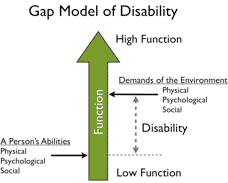
Vol. XI, No. 6, Dec 2011
- Editor's corner
- How some suppliers are ruining many FEC businesses
- Kids' menu trends
- Foundations Entertainment University selected by Amusement Expo Show
- Accessible & universal design
- Why first-to-market often means first-to-fail
- Review of new Dave & Buster's
- Infographic on changes to community-based entertainment spending
- New clients
Accessible & universal design
The American with Disabilities Act (ADA) mandates accessibility design standards for adults in public accommodations, including location-based entertainment venues. One of many shortfalls of the ADA standards is that they do not make a facility accessible and usable by children, either with or without disabilities. Designing for children’s accessibility is especially challenging as children come in different sizes and abilities across their age range.
Our company believes in going beyond the minimum standards of ADA in the design of our projects by following the principal of universal design. Universal design is an approach to the design of products and environments so they can be used by all people, with and without disabilities, to the greatest extent possible, without the need for adaptation or specialized design.  Universal design is an inclusive design approach that extends the benefits of use to many groups of people who are not necessarily classified as having a disability under ADA, but who regularly encounter functional obstacles. This can include short people (including children), tall people, large people, frail people, pregnant women, people who can't read English (immigrants and young children), people carrying packages, parents carrying children or with children in strollers and people with orientation and hearing difficulties, including some senior citizens.
Universal design is an inclusive design approach that extends the benefits of use to many groups of people who are not necessarily classified as having a disability under ADA, but who regularly encounter functional obstacles. This can include short people (including children), tall people, large people, frail people, pregnant women, people who can't read English (immigrants and young children), people carrying packages, parents carrying children or with children in strollers and people with orientation and hearing difficulties, including some senior citizens.
There are seven principles of universal design:
- Equitable Use: The design does not disadvantage or stigmatize any group of users.
- Flexibility in Use: The design accommodates a wide range of individual preferences and abilities.
- Simple, Intuitive Use: Use of the design is easy to understand, regardless of the user's experience, knowledge, language skills, or current concentration level.
- Perceptible Information: The design communicates necessary information effectively to the user, regardless of ambient conditions or the user's sensory abilities.
- Tolerance for Error: The design minimizes hazards and the adverse consequences of accidental or unintended actions.
- Low Physical Effort: The design can be used efficiently and comfortably, and with a minimum of fatigue.
- Size and Space for Approach & Use: Appropriate size and space is provided for approach, reach, manipulation, and use, regardless of the user's body size, posture, or mobility.
Over our 22-years’ experience of designing all types of location-based leisure and educational facilities, our company has developed a set of universal design criteria and standards that we follow on all projects to assure that they are fully accessible to the broadest possible group of people. This includes making projects family-friendly (especially mom- and child-friendly) and grandparent-friendly if they are attracting the family market, even if that is only a small segment of all the customers.
We find that universal design makes location-based leisure facilities attractive to the largest market of people, so it’s not only good business as it maximizes attendance; it’s the right thing to do.
Vol. XI, No. 6, Dec 2011
- Editor's corner
- How some suppliers are ruining many FEC businesses
- Kids' menu trends
- Foundations Entertainment University selected by Amusement Expo Show
- Accessible & universal design
- Why first-to-market often means first-to-fail
- Review of new Dave & Buster's
- Infographic on changes to community-based entertainment spending
- New clients


